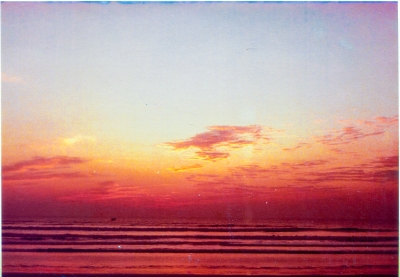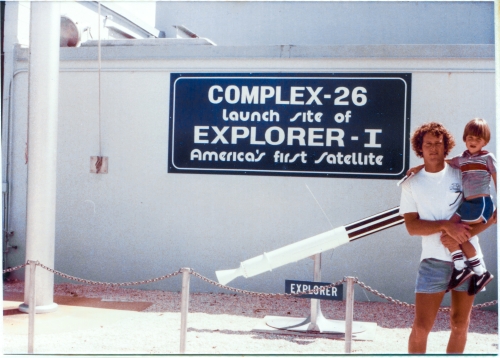The Construction of Space Shuttle Launch Complex 39-B
A very personal and technical written and photographic history, by James MacLaren.
Home Life: Page 1 - At The Space Museum... In Reactive Air.
| Pad B Stories - Table of Contents |
And you stop at The Islander Hut on your way in to another workday at the pad. And you take a picture looking east, just before the sun comes up. And this is what you see. And this is what you are becoming.
And Fate decreed you be allowed to have a son. And only one child do you have in all the world. And you love your son, very much, and your son Kai loves you, very much, and the both of you also love human creations of stainless-steel and fire which fly ten-times faster than a rifle bullet, far above the realm of clouds, into the fathomless mysteries beyond, and you live in a place where such things are created and flown, and some are even kept on display in an obscure, near-unknown, museum that you visit every chance you get, and you are given many chances indeed, oftentimes just the two of you together, and not another soul to be seen anywhere around, and many visits are made there together, and it is good.
At the Air Force Space Museum on Cape Canaveral.
Cape Canaveral.
One of those place names that's just saturated with history. Very recent history to be sure, but a history as deep and profound as any other, the world around. A name which is instantly-recognizable, the world around.
A place where impossible things were done. Where people rose above themselves so far that they wound up leaving the Earth.
To this day, the human brain still has trouble with what those people did then, and what those people continue to do today.
And, by my lights, the human brain never will really, properly, come to terms with any of it.
To go to a place where there is no air, no water, no rock, no thing.
To travel at five miles per second,.
No. Wait. Seven. Seven miles per second.
Nah, never happened.
There's no way any such kind of thing ever did happen. Ever could happen.
And yet...
And yet there sits the flight hardware.
In mute testimony.
The hardware does not need words.
It is enough, it is more than enough, in and of itself, it is enough that it simply exists.
And so it does, and so it is.
The museum in the form which you see in the following images no longer exists. It is no longer a place you can simply drive to without further consideration, preparation, or authorization.
We lived right down State Road A1A from this place, and we would just get in the car and go there.
Like you would go to the corner store.
Like it was nothing.
Nothing at all.
You can no longer do this.
The museum itself has been moved to a location outside of the restricted areas of Cape Canaveral Air Force Station.
Launch complexes 26 & 5/6 are no longer accessible to just anybody.
You must now arrange with the cognizant authorities for a visit there.
You can no longer visit the place alone, on your own, gleefully discover there to be literally not one other person there, and romp with a child who's eyes sparkled in a way that simply cannot be put into words, between the Snark and the LARC, the no-go Navaho and the fat-ass Atlas, the Thor-Able and the Mercury Redstone, and the blockhouse and the gantry, and the cable trenches and the culverts, and the living embodiments of that preternatural marriage of stainless steel and fire which cannot possibly ever have happened.
And yet... it did.
Most of the hardware has been removed, thankfully.
It was a joy beyond describing to have been able to simply walk amongst it, to be able to lay respectful hands upon it, but the air...
The air in Cape Canaveral is a different thing.
The air in Cape Canaveral is a subtle thing.
The air in Cape Canaveral is slow, oh so very slow, but it is relentless and it never stops.
The air in Cape Canaveral is reactive.
The air in Cape Canaveral attacks things. It applies mold to inert surfaces in a way that cannot be recovered from. It bleaches things to pale skeletal shades of death slowly creeping. It takes the finish, takes the shine, completely off of things. It penetrates into the invisible grain of robustly-solid objects and enters waterproof places with a stealth and patience that defies belief. It renders aluminum to a ghastly gray powder. Plastic loses its color, grows brittle, cracks, and eventually falls to pieces under a force no greater than its own weight. Stainless-steel actually rusts. Common steel develops endlessly-growing dark-orange lesions and cankers, exfoliates and dissolves, swells up and sunders heavy concrete emplacements. The air in Cape Canaveral must be experienced to be believed. And it works so slowly. So very very slowly.
You cannot feel it. And there are many who have not spent enough time experiencing it to see what it is truly capable of, how truly destructive it is, and who therefore are unable to believe you when you warn them.
And it was attacking the hardware. The flight hardware sitting defenselessly out beneath a sun that is also a thing that has to be experienced to be believed.
And so they've taken it all away.
They've taken it to a safer place.
And, without sensible budget to do so, they are attempting to restore it.
I can only hope they succeed, because if they do not, there will come a day when all of it is simply gone.
And our thanks for having been given the grace we were given. For having been able to walk amongst it all. While it still existed.
Our thanks knows no bounds, and we are full-aware of just how lucky we were.
We are.
And will remain.
Cape Canaveral.
One of those place names that's just saturated with history. Very recent history to be sure, but a history as deep and profound as any other, the world around. A name which is instantly-recognizable, the world around.
A place where impossible things were done. Where people rose above themselves so far that they wound up leaving the Earth.
To this day, the human brain still has trouble with what those people did then, and what those people continue to do today.
And, by my lights, the human brain never will really, properly, come to terms with any of it.
To go to a place where there is no air, no water, no rock, no thing.
To travel at five miles per second,.
No. Wait. Seven. Seven miles per second.
Nah, never happened.
There's no way any such kind of thing ever did happen. Ever could happen.
And yet...
And yet there sits the flight hardware.
In mute testimony.
The hardware does not need words.
It is enough, it is more than enough, in and of itself, it is enough that it simply exists.
And so it does, and so it is.
The museum in the form which you see in the following images no longer exists. It is no longer a place you can simply drive to without further consideration, preparation, or authorization.
We lived right down State Road A1A from this place, and we would just get in the car and go there.
Like you would go to the corner store.
Like it was nothing.
Nothing at all.
You can no longer do this.
The museum itself has been moved to a location outside of the restricted areas of Cape Canaveral Air Force Station.
Launch complexes 26 & 5/6 are no longer accessible to just anybody.
You must now arrange with the cognizant authorities for a visit there.
You can no longer visit the place alone, on your own, gleefully discover there to be literally not one other person there, and romp with a child who's eyes sparkled in a way that simply cannot be put into words, between the Snark and the LARC, the no-go Navaho and the fat-ass Atlas, the Thor-Able and the Mercury Redstone, and the blockhouse and the gantry, and the cable trenches and the culverts, and the living embodiments of that preternatural marriage of stainless steel and fire which cannot possibly ever have happened.
And yet... it did.
Most of the hardware has been removed, thankfully.
It was a joy beyond describing to have been able to simply walk amongst it, to be able to lay respectful hands upon it, but the air...
The air in Cape Canaveral is a different thing.
The air in Cape Canaveral is a subtle thing.
The air in Cape Canaveral is slow, oh so very slow, but it is relentless and it never stops.
The air in Cape Canaveral is reactive.
The air in Cape Canaveral attacks things. It applies mold to inert surfaces in a way that cannot be recovered from. It bleaches things to pale skeletal shades of death slowly creeping. It takes the finish, takes the shine, completely off of things. It penetrates into the invisible grain of robustly-solid objects and enters waterproof places with a stealth and patience that defies belief. It renders aluminum to a ghastly gray powder. Plastic loses its color, grows brittle, cracks, and eventually falls to pieces under a force no greater than its own weight. Stainless-steel actually rusts. Common steel develops endlessly-growing dark-orange lesions and cankers, exfoliates and dissolves, swells up and sunders heavy concrete emplacements. The air in Cape Canaveral must be experienced to be believed. And it works so slowly. So very very slowly.
You cannot feel it. And there are many who have not spent enough time experiencing it to see what it is truly capable of, how truly destructive it is, and who therefore are unable to believe you when you warn them.
And it was attacking the hardware. The flight hardware sitting defenselessly out beneath a sun that is also a thing that has to be experienced to be believed.
And so they've taken it all away.
They've taken it to a safer place.
And, without sensible budget to do so, they are attempting to restore it.
I can only hope they succeed, because if they do not, there will come a day when all of it is simply gone.
And our thanks for having been given the grace we were given. For having been able to walk amongst it all. While it still existed.
Our thanks knows no bounds, and we are full-aware of just how lucky we were.
We are.
And will remain.

